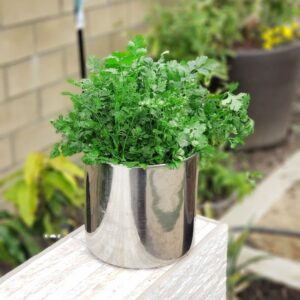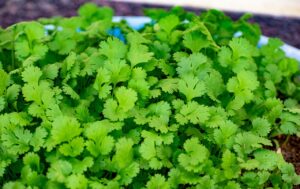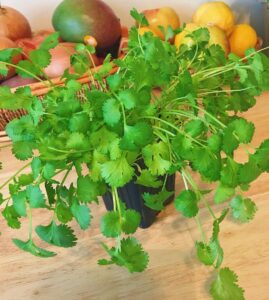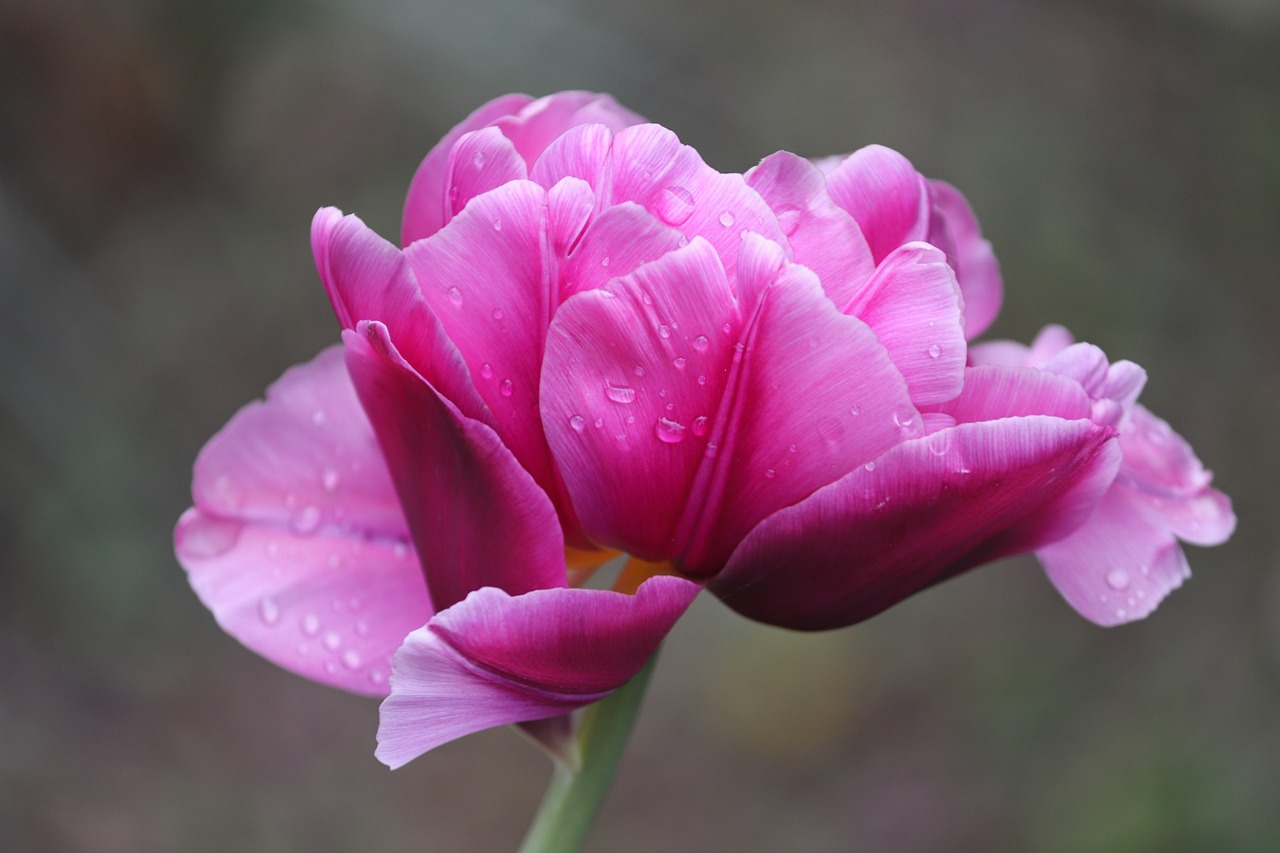Discover the best tips for Growing Cilantro in Pots – a space-saving solution for fresh and flavorful herbs in your home!
Growing cilantro in pots is a convenient way to plant this herb in limited space. With the right care and suitable containers, you can enjoy fresh cilantro leaves for culinary delights right at your fingertips.
Read Tips to Grow Marigold Plants from Cuttings
Propagating Cilantro

- Obtain cilantro seeds from a reliable source, such as a local nursery or garden center. Alternatively, you can save seeds from a mature cilantro plant by allowing it to flower and produce seeds.
- If you’re starting cilantro indoors, fill seed trays or small pots with the potting mix.
- Sow the seeds 1/4 inch deep.
- After germinating the seeds in a seed tray, transfer the young plants to their permanent location once they have developed 2-3 leaves.
Learn Apple Tree Care in Containers
Points to Consider while Growing Cilantro in Pots from Seeds
- When using seeds from the grocery store, it is advisable to gently crush the seed husk before sowing. In the case of whole seeds purchased from seed companies, if they are unopened, you can slightly crush or rub them between your hands or on the ground.
- To enhance the germination rate of coriander seeds, it is crucial to remove the husk or covering that encloses the seeds.
- For optimal results, sow cilantro seeds directly into the final pot where you intend to grow the plants. Cilantro has a long taproot, and it does not transplant well, particularly as the plant begins to mature.
Choosing a Container
A common mistake people make when growing cilantro is selecting pots that are too shallow. Just like dill, cilantro requires a deep and wide container.
To grow abundant and healthy cilantro in a pot, opt for one that has a minimum depth of 8 inches. If possible, consider using a window box or a large plastic tub, as they provide an ideal size for cilantro growth.
Best Time for Planting Cilantro in Pots
Begin planting cilantro once the threat of frost has passed completely. This herb can be grown in succession from spring through fall. In regions with warm temperate climates and hotter areas (USDA Zone 8 and above), cilantro can also be grown during winters with proper care.
Cilantro is quite resilient and can tolerate light frost without difficulty. In regions cooler than zone 8b, where temperatures are significantly colder, you have the option to grow cilantro indoors, in cold frames, or in hothouses, allowing you to overwinter the herb successfully.
In hot tropical climates like USDA Zone 10 – 11, cilantro thrives during the fall and winter seasons. However, in such climates, it is possible to grow cilantro year-round, as fresh cilantro leaves are readily available throughout many tropical countries. Nonetheless, it is important to address the issue of bolting. Quick harvesting and providing shade during spring and summer may be necessary to manage the tendency of cilantro to bolt in these seasons.
Check the Basil Plant Care Tips
Needs for Growing Cilantro in Pots

Location
Cilantro thrives in sunny locations; however, it is important to exercise caution as excessive heat can cause it to go to seed quickly. During summer or in hot climates, it is advisable to position cilantro in an area that receives shade.
Soil
While growing cilantro in pots use neutral soil that is rich in organic matter and has a crumbly texture. Adding aged manure or compost to the soil for a consistent supply of nitrogen and other essential trace elements.
Water
Cilantro thrives in soil that is consistently moist, so it is important to water it regularly and thoroughly. When watering, take care not to wet the foliage, as this can make the plant more susceptible to powdery mildew.
Additionally, avoid overwatering and waterlogging the soil, as cilantro prefers well-drained conditions.
Spacing
You can plant cilantro plants close together, but it’s best to leave about 3-4 inches of space between each plant for them to grow well.
Check Hibiscus Sabdariffa Care
Cilantro Plant Care in Pots

Fertilizer
To help your cilantro grow well in pots, you can feed it every two months with a nitrogen-rich fertilizer that is diluted by half. This will promote the growth of its leaves. If you’re using compost or aged manure to nourish the plants, you won’t need to fertilize them too often.
Using fish emulsion is also suggested for better results. Just be careful not to use too much fertilizer, as it can make your harvest less flavorful.
Deadheading
Take a look at your cilantro plants occasionally to check if they are producing flowers. If you notice flowers, it’s a good idea to remove them regularly to encourage more leaf growth. However, if you want your plants to produce seeds, you can choose to leave the flowers as they are.
Pests and Diseases
Watch out for aphids and mites, as they can harm cilantro plants. The most common pest that affects cilantro is mildew, which tends to occur more frequently in warm and humid weather.
To prevent powdery mildew, make sure there is enough space between the plants, allowing air to circulate properly. Avoid watering the plants from above, as this can cause the leaves to get wet, which in turn encourages the growth of various fungal infections.
Check Tips to Grow Insulin Plant
Harvesting Cilantro in Pots

You can begin harvesting young cilantro leaves approximately 3-4 weeks after planting the seeds. Once the leaves have grown to a length of 5-8 inches, you can pick them from the plant.
If you prefer to harvest the entire plant, it’s best to wait for at least 45-70 days. Cut the entire plant either at soil level or approximately 2 inches above the crown.
Learn growing Ashwagandha in the Home
Common Problems with Coriander / Cilantro

A common issue with cilantro is known as bolting. This happens when the plant starts to produce seeds prematurely, especially in hot weather. The flowers appear rapidly and quickly turn into seeds. Once the plant has seeded, it typically dies.
To address this problem, a recommended solution is to sow cilantro seeds in succession. Plant new seeds every other week to ensure a continuous harvest. Additionally, when you notice the plant starting to bolt, gently pinch off the top to slow down the process.



